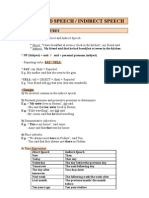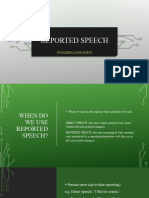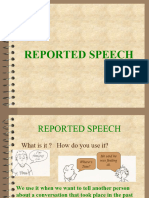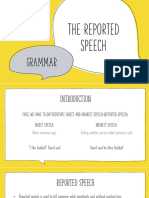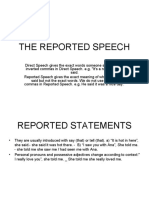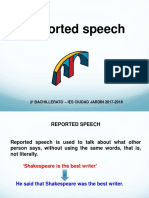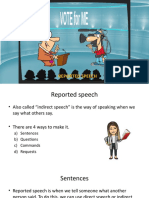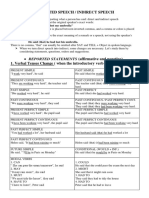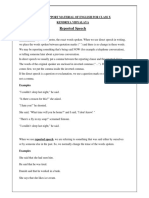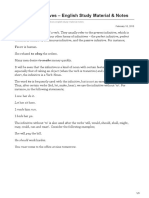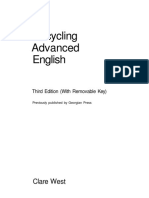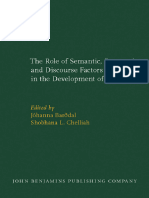Grammar- Report speech
viernes, 20 de setiembre de 2024 17:47
Direct Speech Tense Reported Speech Tense Example in Direct Example in Reported
Speech Speech
Present simple Past simple "I go to work." He said (that) he went to
work.
Present continuous Past continuous "I am working." He said (that) he was
working.
Past simple Past perfect "I went to the He said (that) he had gone
cinema." to the cinema.
Present perfect Past perfect "I have finished He said (that) he had
the report." finished the report.
Present perfect Past perfect continuous "I have been He said (that) he had been
continuous working." working.
Past continuous Past perfect continuous "I was working." He said (that) he had been
working.
Past perfect (No change) "I had finished." He said (that) he had
finished.
Future (will) Would "I will go He said (that) he would go
tomorrow." the next day.
Going to (future) Was/Were going to "I am going to He said (that) he was
travel." going to travel.
Future continuous Would be "I will be working." He said (that) he would be
(will be) working.
Future perfect (will Would have "I will have He said (that) he would
have) finished." have finished.
Conditional simple (No change) "I would do it." He said (that) he would do
(would) it.
Conditional perfect (No change) "I would have He said (that) he would
(would have) gone." have gone.
Notas adicionales:
• Present perfect (has been delayed) → Past perfect (had been delayed).
• Past continuous (was working) → Past perfect continuous (had been working).
Tipo de Pregunta Direct Speech Reported Speech
Yes/No questions "Are you coming?" She asked if I was coming.
Wh- questions "Where do you live?" He asked where I lived.
Yes / No question "Do you enjoy travelling? She asked if I enjoyed travelling
(present)
Yes/No question (past) "Did she finish the He asked if she had finished the work.
work?"
Wh- question (future) "When will they arrive?" She asked when they would arrive.
Yes/No question "Is he studying?" She asked if he was studying.
(present continuous)
INT 12 página 1
�(present continuous)
Wh- question (past "What were you doing?" He asked what I had been doing.
continuous)
Yes/No question "Have you seen the She asked if I had seen the movie.
(present perfect) movie?"
Wh- question (present "How long have you He asked how long I had been there.
perfect) been here?"
Reporting verbs
We can use reportin verbs to report the nature or attitude of what was said, e.g He promised…, She
offered…, He suggested…
Reporting verbs are followed by a number of different structures.
- Verb + (that) + clause: add, admit, arguee, claim, complain, deny, explain, mention, predict,
promise, suggest, tell, think, warn
○ Helen promised (that) she woudn't be late.
- Verb + person + (that) + clause: assurem convince, inform, promise, reassure, remind, warn.
○ She reassured me that everything was ok
*When we use a reporting verb followed by a (that) clause, we usually change the verb by moving it
back one tense.
The room is too small -> He complained that the room was too small.
I think they'll win 2-0 -> He predicted they'd win 2-0
- Verb + to ´infinitive: agree, ask, demand, offer, promise, refuse, threaten
○ Jana agrred to come with us
- Verb + person + to + infinitive_ advise, convince, encourage, invite, order, persuade, remind,
tell, warn, point out
○ Xavier advised me to talk to my boss.
- Verb + (preposition) + -ing: admit, apologize for, deny, insist on, suggest
○ He didn't apologize for being late
- Verb+ person + preposition+ -ing: accuse…of, blame…for, congratulate… on/for. Praise…for,
thank…for, warn… against
○ Did you thank Claire for helping you?
- Note that some verbs can be followed by more than one structure.
○ He admitted that he had broken the window o He admitted breaking the window-
¿Qué son los reporting verbs?
Los reporting verbs son verbos que usamos para reportar lo que alguien dijo o hizo, pero también
para transmitir la naturaleza o actitud de lo que se dijo. Algunos ejemplos comunes son: promise
(prometer), offer (ofrecer), suggest (sugerir), warn (advertir), ask (preguntar), entre otros.
Cada uno de estos verbos puede ir seguido de diferentes estructuras:
Estructuras comunes con reporting verbs:
1. Verbo + (that) + oración
Usamos este tipo de estructura para reportar declaraciones con verbos como: add (añadir), admit
(admitir), explain (explicar), promise (prometer), etc.
Ejemplos:
• Direct speech: "I will not be late."
• Reported speech: Helen promised (that) she wouldn't be late.
(Helen prometió que no llegaría tarde).
• Direct speech: "The room is too small."
• Reported speech: He complained (that) the room was too small.
(Él se quejó de que la habitación era demasiado pequeña).
INT 12 página 2
� (Él se quejó de que la habitación era demasiado pequeña).
2. Verbo + persona + (that) + oración
Esta estructura incluye un objeto (persona), y algunos verbos comunes son: assure (asegurar),
inform (informar), remind (recordar), warn (advertir).
Ejemplos:
• Direct speech: "Everything is okay."
• Reported speech: She reassured me (that) everything was okay.
(Ella me aseguró que todo estaba bien).
3. Verbo + infinitivo
Algunos verbos van seguidos de un infinitivo (verbo en su forma base con "to"), como: agree
(acordar), offer (ofrecer), promise (prometer).
Ejemplo:
• Direct speech: "I will come with you."
• Reported speech: Jana agreed to come with us.
(Jana acordó venir con nosotros).
4. Verbo + persona + infinitivo
Aquí, un verbo seguido de una persona (objeto) y luego el infinitivo. Verbos comunes incluyen:
advise (aconsejar), encourage (animar), invite (invitar), warn (advertir).
Ejemplo:
• Direct speech: "Talk to your boss."
• Reported speech: Xavier advised me to talk to my boss.
(Xavier me aconsejó hablar con mi jefe).
5. Verbo + preposición + gerundio (-ing)
Algunos verbos requieren una preposición seguida de un verbo en gerundio (forma -ing), como:
admit (admitir), apologize for (disculparse por), deny (negar), suggest (sugerir).
Ejemplo:
• Direct speech: "I was late."
• Reported speech: He apologized for being late.
(Él se disculpó por llegar tarde).
6. Verbo + persona + preposición + gerundio (-ing)
Estos verbos incluyen una persona y una preposición antes del verbo en gerundio (-ing). Ejemplos
incluyen: blame…for (culpar), thank…for (agradecer), warn…against (advertir en contra de).
Ejemplo:
• Direct speech: "Claire helped you."
• Reported speech: Did you thank Claire for helping you?
(¿Le agradeciste a Claire por ayudarte?).
Cambios de tiempos en el Reported Speech:
Cuando usas reporting verbs que llevan una oración (verb + that clause), sí se aplican las reglas de
cambio de tiempos que vimos en la primera tabla. Por ejemplo:
• Direct speech: "I am going to win."
• Reported speech: He said (that) he was going to win.
(Él dijo que iba a ganar).
El verbo "said" hace que cambiemos el presente continuo "am going" a pasado continuo "was
going".
Ejemplos en positivo, negativo y pregunta:
Positivo:
• Direct speech: "I will help you."
• Reported speech: She promised to help me.
(Ella prometió ayudarme).
Negativo:
• Direct speech: "I won’t be late."
• Reported speech: He promised (that) he wouldn't be late.
(Él prometió que no llegaría tarde).
Pregunta:
INT 12 página 3
�Pregunta:
• Direct speech: "Will you come with me?"
• Reported speech: She asked if I would come with her.
(Ella preguntó si iría con ella).
Resumen:
1. Los verbos de reporte son importantes para mostrar cómo alguien dice algo (actitud o
naturaleza).
2. Algunos verbos requieren estructuras específicas como el uso de to-infinitive, gerund (-ing), o
una cláusula con that.
3. Sí se aplican las reglas de cambio de tiempos verbales del reported speech cuando usamos
verbos seguidos de una oración (that clause).
1. ¿Por qué desaparece el "will" en la estructura verbo + infinitivo?
En la estructura verbo + infinitivo, no necesitamos usar "will" porque estamos reportando una
acción futura usando el infinitivo (la forma base del verbo con to). El "to + infinitive" ya indica la
intención o el futuro de la acción, por lo que no es necesario agregar "will".
Por ejemplo:
• Direct speech: "I will help you."
• Reported speech: She promised to help me.
En este caso, el verbo promised ya sugiere un compromiso o una acción futura, por lo que el uso de
"to help" (en vez de "will help") es suficiente para expresar esa idea.
2. Versiones en negativo y pregunta de cada estructura:
Vamos a ver cómo se transforman estas estructuras con negaciones y preguntas. También te daré
ejemplos de cada estructura para que lo veas más claro.
Estructura 1: Verbo + (that) + oración
Positivo:
• Direct speech: "The room is too small."
• Reported speech: He complained (that) the room was too small.
Negativo:
• Direct speech: "The room isn't big enough."
• Reported speech: He complained (that) the room wasn't big enough.
Pregunta:
• Direct speech: "Is the room too small?"
• Reported speech: He asked if the room was too small.
Estructura 2: Verbo + persona + (that) + oración
Positivo:
• Direct speech: "Everything is okay."
• Reported speech: She reassured me (that) everything was okay.
Negativo:
• Direct speech: "Everything isn't fine."
• Reported speech: She reassured me (that) everything wasn't fine.
Pregunta:
• Direct speech: "Is everything okay?"
• Reported speech: She asked me if everything was okay.
Estructura 3: Verbo + infinitivo
Positivo:
• Direct speech: "I will help you."
• Reported speech: She promised to help me.
Negativo:
• Direct speech: "I will not help you."
• Reported speech: She promised not to help me.
INT 12 página 4
� • Reported speech: She promised not to help me.
En este caso, "not" se coloca antes del infinitivo ("to help") para formar la negación. El "will" ya no
aparece porque la negación se hace en el infinitivo.
Pregunta:
• Direct speech: "Will you help me?"
• Reported speech: She asked to help me.
Esta estructura es un poco menos común en forma de pregunta, porque generalmente, al hacer
preguntas, usamos otras estructuras como Verbo + persona + to-infinitive o el uso de if/ whether
para indirect questions.
Estructura 4: Verbo + persona + infinitivo
Positivo:
• Direct speech: "Talk to your boss."
• Reported speech: Xavier advised me to talk to my boss.
Negativo:
• Direct speech: "Don't talk to your boss."
• Reported speech: Xavier advised me not to talk to my boss.
Aquí también, la negación se coloca antes del infinitivo ("to talk").
Pregunta:
• Direct speech: "Should I talk to my boss?"
• Reported speech: Xavier asked me to talk to my boss.
Estructura 5: Verbo + preposición + gerundio (-ing)
Positivo:
• Direct speech: "I was late."
• Reported speech: He apologized for being late.
Negativo:
• Direct speech: "I wasn’t late."
• Reported speech: He apologized for not being late.
La negación se hace agregando "not" antes del gerundio ("being").
Pregunta:
• Direct speech: "Were you late?"
• Reported speech: He asked me for being late.
Estructura 6: Verbo + persona + preposición + gerundio (-ing)
Positivo:
• Direct speech: "Claire helped you."
• Reported speech: Did you thank Claire for helping you?
Negativo:
• Direct speech: "Claire didn't help you."
• Reported speech: Did you blame Claire for not helping you?
Pregunta:
• Direct speech: "Did Claire help you?"
• Reported speech: Did you ask Claire for helping you?
Resumen:
• En la estructura verbo + infinitivo, "will" desaparece porque la acción futura ya está indicada
con el infinitivo.
• Para las versiones negativas, se agrega "not" antes del infinitivo o gerundio.
• Las preguntas siguen las reglas normales del reported speech, usando if o whether para
indirect questions, o reestructurando la oración con el verbo adecuado.
1. Usar el presente con reporting verbs
Usamos el presente con los reporting verbs cuando la acción que estamos reportando es reciente o
todavía es relevante en el presente. También se usa el presente cuando el verbo reporta algo que
INT 12 página 5
�todavía es relevante en el presente. También se usa el presente cuando el verbo reporta algo que
ocurre regularmente o cuando es un hecho general.
Casos para usar el presente:
• Para reportar algo que alguien dice o piensa en el momento actual.
○ Ejemplo: She says (that) she is tired.
▪ Ella dice que está cansada. (Lo dice ahora).
• Cuando la información reportada sigue siendo válida o es un hecho permanente.
○ Ejemplo: He thinks (that) the world is round.
▪ Él piensa que el mundo es redondo. (Un hecho general, no cambia).
• Para reportar instrucciones o advertencias inmediatas.
○ Ejemplo: I warn you not to touch that!
▪ Te advierto que no toques eso! (La advertencia se está haciendo ahora).
Ejemplo de reporting verb en presente:
• Direct speech: "I am tired."
• Reported speech: She says she is tired.
○ "Says" está en presente porque es algo que está diciendo en este momento.
2. Usar el pasado con reporting verbs
El pasado se usa cuando estás reportando algo que ya ocurrió o cuando estás hablando de algo que
alguien dijo o pensó en el pasado. Esta es la forma más común cuando haces discurso indirecto
(reported speech) sobre una acción pasada.
Casos para usar el pasado:
• Para reportar algo que alguien dijo o pensó en un momento anterior.
○ Ejemplo: She said (that) she was tired.
▪ Ella dijo que estaba cansada. (Dijo esto en el pasado).
• Cuando estás contando una historia o hablando de eventos pasados.
○ Ejemplo: They warned me not to go there.
▪ Me advirtieron que no fuera allí. (La advertencia ocurrió en el pasado).
Ejemplo de reporting verb en pasado:
• Direct speech: "I am tired."
• Reported speech: She said she was tired.
○ "Said" está en pasado porque estamos reportando algo que ya dijo.
Cómo saber cuándo usar presente o pasado con reporting verbs:
1. Contexto actual (presente):
○ Si la acción que reportas ocurre ahora mismo o todavía es válida, usa el presente.
○ Ejemplo: She says she is happy. (Lo está diciendo en este momento).
2. Contexto pasado:
○ Si la acción que reportas ya ocurrió en el pasado y no está conectada directamente con
el presente, usa el pasado.
○ Ejemplo: She said she was happy. (Lo dijo en el pasado).
3. Excepciones y flexibilidad:
• Si estás reportando hechos generales o verdades universales, puedes usar el presente en el
reported speech incluso si el reporting verb está en pasado.
○ Ejemplo: He said the earth is round. (Aquí el reporting verb está en pasado, pero "the
earth is round" es un hecho que sigue siendo verdad, por lo que el verbo de la oración
principal se mantiene en presente).
4. Regla de retroceso de tiempos (Backshifting):
Normalmente, cuando el reporting verb está en pasado (como "said", "warned", etc.), el tiempo del
verbo en el reported speech retrocede un tiempo. Ejemplo:
• Direct speech: "I am tired."
• Reported speech (past): She said she was tired.
(El "am" cambia a "was" porque el reporting verb está en pasado).
Sin embargo, si el reporting verb está en presente (como "says", "thinks", "warns"), no necesitas
INT 12 página 6
�Sin embargo, si el reporting verb está en presente (como "says", "thinks", "warns"), no necesitas
cambiar el tiempo de la acción reportada. Ejemplo:
• Direct speech: "I am tired."
• Reported speech (present): She says she is tired.
(Aquí no cambia, porque "says" está en presente).
Resumen:
• Usa el presente con reporting verbs cuando la acción que reportas es actual o todavía es
válida (algo que ocurre ahora o es un hecho general).
• Usa el pasado con reporting verbs cuando la acción que reportas ya ocurrió en el pasado.
• La regla de retroceso de tiempos (backshifting) se aplica cuando el reporting verb está en
pasado, y debes cambiar el tiempo del verbo en la acción reportada.
Espero que esto te haya aclarado cuándo usar el presente o pasado en los reporting verbs. Si
necesitas más ejemplos o una explicación más detallada, ¡solo avísame!
4o
INT 12 página 7






